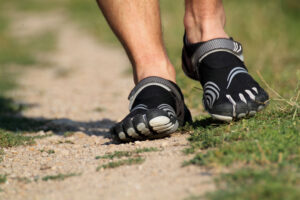Once upon a time, long, long ago, there were people who lived in caves. These people were without smartphones, TV’s, couches, and even shoes! They walked around, climbed trees, hunted for food, and ran away from danger, all without shoes. In fact, anywhere they ran they were running barefoot!
Now, I’m not sure exactly how it all went down, but I think these people were tired of stepping on those little pokey things you find in the grass and they decided to do something about it. That’s when the first shoe was created, (probably out of an animal hide and some dried intestine to hold it on, I’m not sure, I wasn’t there).
I’m willing to bet though, that this “shoe” did not include an arch support or extra cushioning for those who had and impactful heel strike as they ran to chase down some dinner. Maybe those people did just fine with no shoes or minimal foot coverings, but then later (much later) running shoes were invented in all their bright colored, memory foam-filled, cushioned glory, and then we all got spoiled.
You may also like: Weight Loss or Fat Loss? Which is better?
4 Things You Should Know About Running Barefoot
Before you ditch your expensive running shoes and go barefoot, there are a few things to consider. Also, there are some things you might want to do to prepare to make the switch.
1) Are There Any Dangers?
 Sure you will have certain environmental factors with running barefoot. You may “run” into such things as sand spurs, splinters, sticks, even broken glass, pebbles, and other debris. This is where some barefoot running shoes might come in handy. They will protect your feet from these types of things and still let you utilize all the foot muscles to gain strength.
Sure you will have certain environmental factors with running barefoot. You may “run” into such things as sand spurs, splinters, sticks, even broken glass, pebbles, and other debris. This is where some barefoot running shoes might come in handy. They will protect your feet from these types of things and still let you utilize all the foot muscles to gain strength.
Harvard did a study stating that running barefoot has caused people to adjust their stride which puts less impact on the body, making it safe and beneficial to the body. The only negative writings I could find about running barefoot were from running shoe companies (big surprise). As of now, there aren’t any studies stating that running barefoot is dangerous. So kick off your shoes, go for a run, and have some fun!
2) Start Slow
Even if you are a seasoned runner and know exactly what to do, just know that running barefoot is a huge adjustment for the lower body and even your back. Take it slow, feel it out, and be aware of how this style differs from running in shoes. So, make adjustments.
You might find that different muscles fatigue a lot faster without shoes. So, it’s ok to take small breaks and switch to walking for a few minutes in between running while you recover those new found muscles.
3) Pay Attention To Your Foot Strike
If you’re going to attempt running barefoot, especially on a hard surface, you need to be aware of your footing for sure. If you tend to have a pretty hard heel strike, you’re going to want to switch this up which can take some time, practice, and be a bit challenging.
Landing so firmly on the heels first, opens doors to injury, spurs, sore spots, and more. Always try to strike at the ball of the foot and push off with the toes as you’re running. This is a more natural movement, takes the stress off the heel bone, and helps you build the muscles in your feet that running shoes have compensated for.
4) Be Prepared for Some Sore Calves
If you’ve ever done exercises such as heel raises to strengthen and build muscles in your calves, then you know that after a few sets, they start to burn a bit. Well, imagine heel raises for the entire time and distance you’re going to be running. It’s a lot more work for the calves once you’ve changed the impact point of your foot strike to accommodate for running barefoot.
Just as stated previously, you should start slow. If the calves start to burn so much that it’s impairing your time and distance, slow down and walk normally for a while so your body can recover. Then, begin running again after a brief break. Over time, you’ll build up these muscles and adjust to your new running style.


